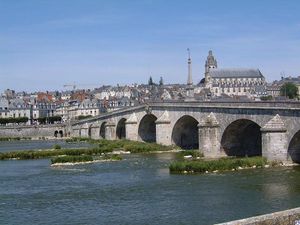Blois
Blois
Uhrenstadt in Frankreich von 1500 bis 1700
Die Schule von Blois
Blois in Frankreich (diesen Ort anzeigen) war zur damaligen Zeit nicht nur eine Hochburg der Emailmalerei, sondern auch ein Zentrum der Uhrmacherkunst. Der Ruf der Stadt begann während der Herrschaft von König Franz I. (1515-1547). Die bemalten Emailgehäuse der Schule von Blois hoben sich neben den Werken der Genfer Schule durch ihre einzigartige Schönheit hervor und wurden nicht nur zu ihrer Zeit hoch geschätzt, sondern auch in den folgenden Jahrhunderten als Meisterwerke der Kunst verehrt.
Blois was the leading watchmakers' center in France at that time. The Paris National Library has a manuscript from 1518 by Jean Sapin, the chief tax-collector in Languedoc, which says: "Julien Coudray, watchmaker in Blois, received 200 golden ecus as payment for two fine daggers with watches in their handles, completely gilded (deux horologes toutes dorees), intended for the king's (Francois I) use." After his death in 1532, Florimond Robert, treasurer to three French kings (Charles VIII, Louis XII and Francois I), left twelve watches (French montre, which means a watch that is carried on the person, unlike house and public clocks; nevertheless, some inventories of Blois watchmakers from the early 17th century mention montres a mentre sur table, which means that montre was sometimes the name used for small table clocks, as well). It was not until 1694 that the French Academy defined the word monstre as watch. At first, this word indicated the dial (monstre d'orloge). However, most of the montres mentioned there were probably watches, especially those that had gold and silver cases. The city of Blois, where Francois I, Charles IX and Henri III held court, developed into one of the leading European watchmaking centers. In the reign of Francois I (1515-1547) three or four watchmakers had workshops there, by 1589 there were already twenty-eight, and in 1610 Blois had sixty-three workshops where watches were made. When John Evelyn visited Blois in 1644, he wrote:"Blois is a town in which the language is spoken correctly; people are very kind; the air is so good that it makes Blois the perfect place for raising the king's children. The people are so ingenious that there is no better place in France for the goldsmith and watchmaking trade.“
Uhrmacher, Goldschmiede und Emailmaler aus Blois
- Verschiedene Mitglieder der bedeutende Uhrmacherfamilie Cuper.
- Chevallier, Nicolas (1).
- Chevallier, Nicolas (2).
- Chevallier, Robert.
- Toutin, Jean (1578-1644).
- Le Roy, Grégoire.
- Le Roy, Pierre (2).
- Robert-Houdin, Jean Eugène.
- Houdin, François Jacques.
- Houdin, Jacques Nicolas.
- Robert, Prosper.
- Janvier, Charles.
- Duduict, Jacques.
- Lemaindre, Nicolas.
- Petitot, Jean.
- Plairas, Salomon.
- Vauquer
- Morlier
